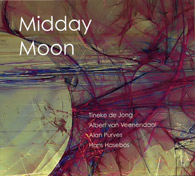de Jong - van Veenendaal - Purves - Hasebos
Midday Moon
(Brokken Records)
There's
a whole class of albums that immediately make the listener "feel good" thanks
to their sounding very enjoyable and pleasant that in time reveal themselves
to be very rich with intelligence in both composition and execution, those
qualities having been obscured at first by their being enjoyable and pleasant.
Midday Moon appears to be a perfect specimen of that category.
Though
not unheard-of (provided I remember correctly), the instrumentation chosen
by the quartet that's featured on this album is definitely of the not-so-common
variety: violin, (prepared) piano, drums/percussion, and marimba. Timbrally
fresh, this combination of instruments is greatly enriched by the woody
character of the marimba (which makes the whole sound more ethnic/chamber-like,
compared to the jazzier-sounding metal vibraphone), and by the fact of
the piano being prepared (which sometimes makes the piano sound quite similar
to a zither or to a "percussive soundboard"); there are also
good-sounding drums, which often pair thin cymbals with big drums; though
the violin player obviously received thorough classical training, the violin
timbre is often on the thin side (it's a compliment, by the way), at times
reminding me of the late Leroy Jenkins.
The
fact of (music) languages spoken here being many, plus the fact of the
instrumental roles being often uncommon, doesn't hurt, either. Nice instrumental
connection among the players, the recorded sound is also good.
Violin
player Tineke de Jong is "first among equals" here; this is the
first time I've heard of her, but her curriculum is long and varied; she
wrote the majority of the pieces on the album. By now I'm quite familiar
with Albert van Veenendaal's (prepared) piano, which I've listened to quite
often, with pleasure, in the last few years. I'm afraid I have to admit
I've never listened to the other quartet members: Alan Purves, on drums
and percussion; and Hans Hasebos, on marimba.
As
per the album's liner notes, jazz standards are one of de Jong's passions,
also one of the musical terrains she explores in the company of van Veenendaal's
piano. The album features three jazz standards: the world-famous Night
And Day by Cole Porter; Day Dream, penned by Ellington and Strayhorn; and
Harlem Nocturne by Earle Hagen (a composition I first heard on Lounge Lizards'
first album). To me, the spirit of these performances sounds quite unlike
the one chosen by the Instant Composers Pool Orchestra - which doesn't
obviously imply that those featured here sound in any way scholastic or
revivalistic! Night And Day is appropriately rich with colours, piano and
violin as its main characters, then a fine piano solo, and some "pushy" drums
rich with different timbres. Day Dream has maybe the richest orchestration
and arrangement on the album, the quartet sounding like a "pocket
orchestra", and an excellent work from the drums, with nice, resonant-sounding
skins. Harlem Nocturne appears in a brief, svelte version, the familiar
theme appearing at the end.
Jazz
is only one of the album's elements, however. Listen to the album's literal
starting point, Midday Moon: an (uncredited) electronic sound intelligently
works as a "canvas" over which a piano ostinato and a chamber-flavoured
theme performed by piano and violin appear, the electronic pulse now in
the background; now the piano sounds jazzy, here's the marimba, then swinging
drums; there's a "dry" solo from the violin, its most rarefied
moment having the electronic sound back again, paired to the
"zither" from the prepared piano; now it's back to the theme, this
time the line being performed by violin and marimba, with a fine drums performance
on cymbals and drums.
Sunday
On Saturn almost sounds like "chamber funk", with the prepared
piano in a rhythmic role alongside marimba and drums, then there's a theme
played by violin, the instrument then performing a "bluesy" solo
over a... calypso! (well, almost).
Arctic
Blues has a "dry", "minimal", development, with a repeating
phrase from the violin, big drums played with mallets, a resonant piano,
and an electronic pulse (is it the "Arctic wind"?).
A Man, A Love is slow, with tempo by piano, drums, marimba, a violin theme,
a fine piano solo, and a nice, subtle, solo part by (I think) a glockenspiel.
Three
tracks were penned by van Veenendaal. Premonition, for solo piano, quite
minimal, trebly sounding, reminded me in some ways of Wayne Horvitz. Friendly
Fire has a bigger-sounding, percussive prepared piano (or are they two,
overdubbed, pianos?). Pebbles And Rocks is a brief duet for piano and violin.
We Are Seeing Things - Hans Hasebos here on percussion - starts as a kinda
"Bo Diddley beat" which soon adds Cuban rhythms. A strange track,
this one, very fine, with timbales a go-go.
Definitely
resembling a jig, Celtic Boop has the violin in a duet with many (overdubbed)
penny whistles, all played by Alan Purves. Appropriately "light",
this track is the right choice after the dense track that came before.
With
a fine, musical progression, the brief I Told It On The Mountain, for solo
violin, brings the album to its logical close.
Beppe Colli
© Beppe Colli 2009
CloudsandClocks.net | Aug. 6, 2009











